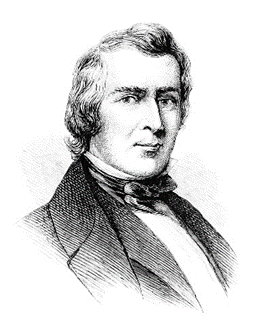History of the Railroad Article Four

The Rail
Solid iron t-rail was developed by Robert Stevens in 1831, who was the President and Engineer of the Camden and Amboy railroad. This design has stood the test of time. A variation of the T-rail is still used today.
Robert received his experience, working with his father in the steamboat industry.

In 1831. Robert de
Popular Science Monthly Volume 12,
Public domain, via Wikimedia Commons
In 1831. Robert decided to go to England to have the solid rails manufactured, where he believed was the best rail. He could not find an American mills that could produce the quality product he wanted. It was not until 1846 that the firm of Cooper and Hewitt of Trenton produced them in America.
While on the voyage, Robert took a block of wood and whittled the model of the T-rail. A simple job of whittling a great ideal, never knowing it would revolutionize the railroad industry.
After Robert arrived in London, he placed the order for his solid rails and purchased the locomotive for his new fledging railroad. The figure below is a reproduced copy of the order Robert gave to the English mill. 1

A reproduced copy of Stevens order
Internet Archive Book Images, No restrictions, via Wikimedia Commons
In May 1832, his company received the first load of 500 rails. The rails were 15 feet long and weighed 15 pounds per yard. They were received in Philadelphia and upon reaching his company, were laid. Soon, the other railroads in the area and then elsewhere in America used the t-tail.
Stevens’ other inventions helped the T-rail to advance the railroad into the powerhouse of the transportation industry. The other inventions credited to him were, the “hook headed spike” and the “fishplate.” 1

Two unused and one heavily corroded w:rail spikes.
Photo by Sean Lamb (User:Slambo), September 3, 2005
File is licensed under the Creative Commons
Attribution-Share Alike 2.0 Generic license.
The stone blocks to run the rails on were very expensive. So, Stevens laid down logs or wooden ties as they were called in America, on ballast or crushed rock to help facilitate drainage and ward off destabilization of the roadbed. 3
When ties were laid down on the ballast, they were aligned and leveled. Then they laid the rails on the wooden ties and fastened down with the hook headed spike. The wooden ties turned out to be a better choice and are also still used today with only a few slight modifications. 3

Shorter Pennsylvania Railroad fish plate
Velocicaptor, Public domain, via Wikimedia Commons
The rails were only 15 feet long. The rails were attached together with fish plates he had also invented.
With the rails being only 15 feet long, the connection would become uneven. When the train passes over the joints it would make a clickety sound. As goes the old saying “Clickety clack, clickety clack… the train goes around the track.”
An engineer mocked, that in America, “poverty is the mother of all invention.” He said this because Stevens had “Used wooden ties as a temporary substitute for the more expensive stone blocks. He finished off by saying, “They made better roads because they were too poor to make a bad one.” 1
Another Stevens invention was the” pilot” or what became known as the forward truck. It is attached to the front of the locomotive. Known also as a cattle catcher, whose job was to push the cattle off the tracks so the train would not derail. Instead, the cattle would become impaled on it, making it extremely hard to detach them. 3
Robert L. Stevens’ inventions left an indelible mark on the railroad’s history. His inventions can still be seen even today with a few variations. There are no life size monuments of his likeness erected. All one must do is look at the miles of track that peppers our countryside to see the most appropriate monument to one’s life and accomplishments.
Robert died never having been married. He also never patented any of his inventions.

Sandbox and delivery pipe
By The original uploader was Schorschi2 at German Wikipedia
- Own work (Original text: Eigene Fotografie), Public Domain, https://commons.wikimedia.org/w/index.php?curid=21209462
In 1836 a plaque of grasshoppers hit Pennsylvania. It was classified as a plaque of biblical proportions. When the locomotives would run over them the locomotive would lose traction. They had a crew to sweep in front of the train. Their efforts were in vain.
Someone had an epiphany. They used sand under the drive wheels to get enough traction to get the train moving. So a sandbox was placed right over the drive wheels an spread over the rails. The picture above is a modern-day sandbox. 1
A lot of the ideals that were incorporated in 1830’s, although they have been improved on, are still in use today.
References:
- The Great Railroad Revolution; The History of Trains in America by Christian Wolmar
- The American Railway: It’s Construction, Development, Management, and Trains by Thomas Curtis Clarke
- Encyclopedia Britannica at Railroad - Open Saloon, Double-Deck Cars, On-Train Dining Car, and Sleeping Cars | Britannica